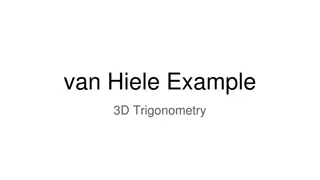Exploring Trigonometry: A Journey Through Mathematical Relationships
Trigonometry, derived from Greek words, is the study of triangle sides and angles. This ancient discipline plays a crucial role in various real-life applications, such as astronomy, navigation, and defense. Delve into the historical background of trigonometry, from its early origins to the advancements by Greek astronomer Hipparchus. Discover the significance of trigonometric ratios, identities, and the practical importance of triangles in precise measurements. Unravel the mathematical beauty and practicality of trigonometry in our daily lives and scientific endeavors.
Download Presentation

Please find below an Image/Link to download the presentation.
The content on the website is provided AS IS for your information and personal use only. It may not be sold, licensed, or shared on other websites without obtaining consent from the author.If you encounter any issues during the download, it is possible that the publisher has removed the file from their server.
You are allowed to download the files provided on this website for personal or commercial use, subject to the condition that they are used lawfully. All files are the property of their respective owners.
The content on the website is provided AS IS for your information and personal use only. It may not be sold, licensed, or shared on other websites without obtaining consent from the author.
E N D
Presentation Transcript
Module 1 of 3 Ratna Rathor AECS-2 Mumbai 1
The word 'trigonometry' is derived from the Greek words 'tri' (meaning three), 'gon' (meaning sides) and 'metron' (meaning measure). In fact, trigonometry is the study of the relationship between the sides and angles of a triangle. tri gon Metron Three Sides Measure 3
OBJECTIVES At the end of this lesson, you will be able to- State the trigonometric ratios of an acute angle in a right-angled triangle. Calculate the trigonometric ratios of an acute angle using Pythagoras Theorem. Establish some identities involving these ratios, called Trigonometric Identities. 4
Trigonometry is said to be the most important mathematical relationship ever discovered. Triangles are one of the most simple forms found in Nature, but their mathematics has vital importance, especially where precise distance measurements are needed. 5
Applications in Real Life In ancient timed, it was used for astronomy in finding the distance of stars. Finding the radius of the earth Finding the height of hills, buildings, trees etc. Navigation Airplane, Ships etc. Defence 6
Historical Background The history of trigonometry dates back to the early age of Egypt and Babylon. Angles were then measured in degrees. It was then advanced by the Greek astronomer Hipparchus in the second century B.C. He compiled a trigonometric table that measured the length of a chord subtending various angles in a circle of a fixed radius r. He is known as the father of TRIGONOMETRY. 7
Hipparchus is considered by some as the greatest astronomer. He was the first Greek to develop quantitative and accurate models for the motion of the Sun and the Moon. With his solar and lunar theories and his numerical trigonometry, he was probably the first to develop a reliable method to predict solar eclipses. 8
Right Triangle The hypotenuseof a right triangle is always the side opposite the right angle. It is the longest side in a right triangle. The adjacent leg is the other side that is adjacent to angle (theta). It is also sometimes called as base. The opposite side is the side that is opposite to angle (theta). It is also sometimes called perpendicular. 9
Right Triangle The sides are always defined with respect to acute angle A or angle C . 10
Reciprocal Functions/Ratios The other trigonometric ratios are cosec , sec and cot . The ratios cosec , sec and cot are the reciprocals of the ratios sin , cos and tan respectively. 15
Secant (Sec) Function/Ratio The secant sec(A) is the reciprocal of cos(A); i.e. the ratio of the length of the hypotenuse to the length of the adjacent side. ??? ? = ?????????? ? ???????? = ? ???? = ? 16
Cosecant (Cosec)Function/Ratio The cosecant or cosec(A), is the reciprocal of sin(A); i.e. the ratio of the length of the hypotenuse to the length of the opposite side. ??? ? = ?????????? ? ???????? = ? ?????? = ? 17
Cotangent(Cot) Function/ Ratio The cotangent cot(A) is the reciprocal of tan(A); i.e. the ratio of the length of the adjacent side to the length of the opposite side. ??? ? = ???????? ? ???????? = ? ???? = ? 18
Example 19
RECAPITULATION Using the given figure, find all the trigonometric ratios for angle A and B. 21
THANK YOU 22























